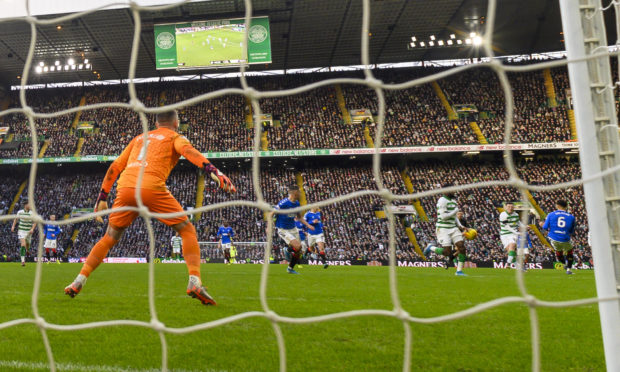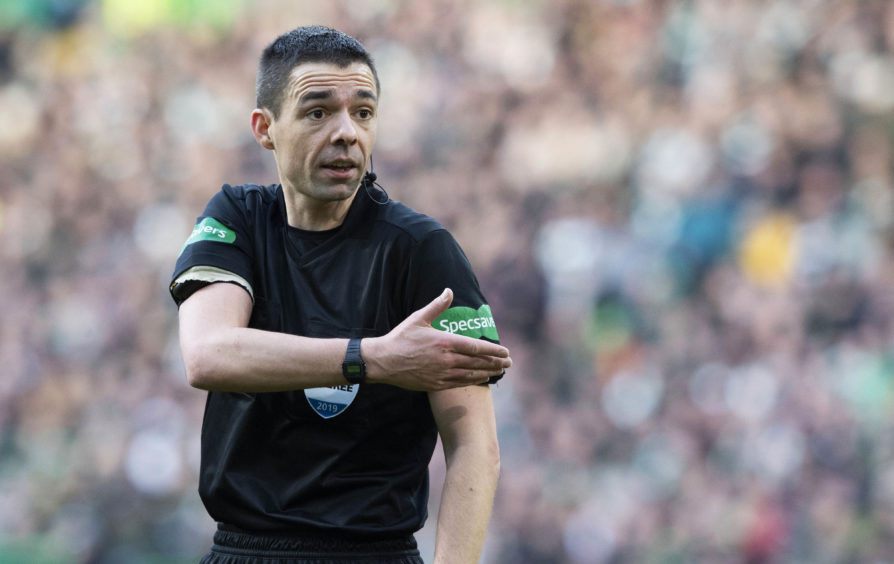
Kevin Clancy has admitted to awarding Celtic a goal-that-never-was in the last Old Firm derby.
And the Grade One referee has cited it as the perfect example of why Scottish football needs VAR.
While Rangers – who were leading at the time – recovered to win 2-1, the incident was nevertheless a hugely controversial moment in the fixture last December.
Clancy, who also sent off Light Blues striker Alfredo Morelos at Celtic Park, acknowledges the mistake but argues it would have been caught by video assistant referee.
He recalled: “A shot was rifled in, it deflected off Odsonne Edouard and went into the net.
“The speed at which it happened – and with the angle I had – it looked to me as though the deflection was off Edouard’s hip, that area of his body.
“In the cold light of day – and it did take the television pundits a couple of replays to work out which part of the anatomy it actually did strike – it looked to have struck Edouard’s hand on the way into the net.
“The laws of the game do not allow that.
“A goal can’t be scored having struck somebody’s hand. That tweak to the law happened at the start of the season.
“If decent camera angles had been available, and it had been possible to quickly identify that the ball touched Edouard’s hand before going into the Rangers net, I think VAR would have been in a good position to quickly identify what had happened.
“I expect the protocol would have been a communication from the VAR to me, asking what I thought happened.
“I would have replied, and been told that the TV replays perhaps show something different, that I would have to come across and have a look at it.
“The decision would have been quickly dealt with.
“The game would have re-started, and there would have been very little discussion after that.”
And getting the big decisions right is, the 36-year-old insists, what his job is all about.
“Every referee steps on the grass wanting to do the best job he can. You want to get everything correct,” he said.
“Split-second decisions can come down to position. It might be judgment.
“You don’t want to come off the football pitch at the end of a game to find out that an important decision, you thought correct in a split-second, turns out not to have been through the lens of several television cameras and slow-motion replays.
“That can impact on your personal life during the week as you come to terms with the fact you haven’t got a big decision correct.”
VAR has come in for heavy criticism in England, especially from fans, and the cost issue preventing it from being introduced in Scotland has been exacerbated by the current lockdown. But Clancy’s enthusiasm for the technology is undiminished.
“Once any teething problems are ironed out and people get used to the protocols, then I think it will be a fantastic addition to the Scottish game,” he said.
“The referees are fully in support of the SFA looking into the implementation of VAR.
“It was great to hear that the Scottish Cup semi-finals had been identified, even on a trial basis.
“I think it would be great because it would give us the best chance possible of making the correct decisions in match.
“And I think it would be good for the profile of Scottish football.
“You only need to look around at comparable leagues in Europe that have either implemented it or are on their way. It would assist our clubs our Europe.
“It could only be an advantage. You would have an extra pair of eyes.
“It’s also worth remembering that the idea is still to let the referee and his assistants officiate the game.
“But it would be a mechanism to catch that handful of decisions a season that, to many people, are obviously wrong.
“Rather than have the debate and dialogue in the papers for days afterwards, the decision can be duly corrected during the match.”

Enjoy the convenience of having The Sunday Post delivered as a digital ePaper straight to your smartphone, tablet or computer.
Subscribe for only £5.49 a month and enjoy all the benefits of the printed paper as a digital replica.
Subscribe © Alan Harvey / SNS Group
© Alan Harvey / SNS Group